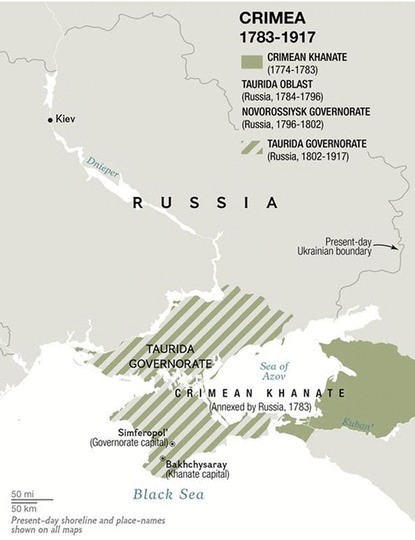The future of Crimea hangs in the balance! The Russians are coming! Quick, we must save it from joining Russia, a fate worse than death!
Perhaps this is a bit melodramatic, but so is much of the rhetoric regarding Crimea that I’ve heard since Ukraine went from protests to crisis. Crimea, in case you haven’t seen a map on the news of late, is a peninsula in the Black Sea attached to Ukraine. It’s separated from Russia at its eastern tip by the Strait of Kerch, which is a mere 2 miles wide at its narrowest. Crimea is ethnically diverse, and the one and only post-Soviet Ukrainian census from 2001 puts the numbers at 58.5% ethnic Russian, 24.4% ethnic Ukrainian, and 12.1% Crimean Tatar.
One of the points I’ve been trying to make is that overestimating the importance of history in Eastern Europe is not possible, and it is the case with Crimea as well. Although Crimea is nominally a part of Ukraine today, it remains an autonomous republic within the country (although it has no areas of competence when it comes to foreign relations). However, Crimea is a very recent addition to Ukraine’s borders.

Prior to 1954, Crimea had changed hands a number of times – but it was never a part of the land that was “Ukraine”. For centuries, Crimea was repeatedly conquered by different forces until the 15th century, when a Mongol established a khanate there. Soon after, the khanate became a protectorate of the Ottoman Empire (although it enjoyed a great deal of autonomy). By the end of the 18th century, the Ottoman Empire was in decline. Russia seized upon the opportunity and engaged the Ottoman Empire in the Russo-Turkish War, handily defeating the Ottomans and annexing Crimea in 1783.
Under the Russian Empire, Crimea became a part of the Taurida Governorate, which contained areas of southern Ukraine as well, where it remained until World War I. Crimea’s strategic location in the Black Sea meant that it was the scene of much fighting during the Crimean War of the mid 19th century, and despite the fact that it was mostly conquered by the combined forces of France, Great Britain, Sardinia, and the Ottoman Empire, the Treaty of Paris, which ended the war, gave Crimea back to the Russian Empire.
Following the collapse of the Russian Empire, Crimea, like Ukraine, changed hands a number of times. Finally, in 1921, the Crimean Autonomous Soviet Socialist Republic was established as a part of the Russian SFSR and subsequently became a part of the Soviet Union. Crimea’s fate under Stalin was similar to that of Ukraine. It suffered from famine, and in 1944, in retaliation for what he claimed were their collaboration with the Nazis during World War II, Stalin had the entire ethnic Tatar population relocated to Central Asia as a form of punishment. Of course, Stalin’s relocations didn’t come with moving trucks and compensation, and about 46% of the deportees died enroute.
Crimea eventually became a part of Ukraine in 1954, in a land transfer that could literally only happen in the Soviet Union, when Nikita Khrushchev, then the Soviet Premier, simply gifted it to Ukraine to celebrate 300 years of Russian-Ukrainian friendship. Of course, things like that were totally grand in the Soviet Union, because it was just one big happy family, and who cares if Russia just gives Crimea to Ukraine, Russia controls Ukraine, and Crimea’s nominally autonomous anyway. Apparently Soviet leaders, like most politicians who don’t bother with foresight, didn’t ever conceive of the Soviet Union collapsing.
But of course it did. In 1992, Crimea agreed to remain a part of Ukraine in exchange for becoming even more autonomous than it already was. Meanwhile, Tatars began returning from Central Asia, exacerbating ethnic tensions. Russia, Ukraine, and Crimea handled the disintegration process rather poorly and were left with a peninsula containing an ethnically diverse population dominanated by an imported group of people, and Russia’s only warm-water naval base, which exists on Ukrainian soil. Not that this was a recipe for administration problems at all.
It’s not at all surprising that tensions in Crimea are boiling over. In 2009, ethnic Russians in Crimea protested against Ukraine, and in 2010, the renewal of Russia’s lease on the military wharf and installations in Sevastopol until 2042 caused chaos to erupt in the Verkhovna Rada, Ukraine’s parliament. Russia’s unwillingness to abandon Sevastopol and develop other potential warm water naval bases, for example at Novorossiysk (where a new naval base is very slowly being built), demonstrates its continued interest in Crimea, which is also a very popular spot for Russian tourists. While Crimea may be attached to Ukraine, it is not Ukrainian in the same way that other areas of Ukraine are, even those in the east, especially with the enhanced autonomy afforded to it after the collapse of the Soviet Union.
Predicting the outcome of the March 16 referendum based on current available data is difficult, because it makes it pretty obvious that most Crimeans’ loyalty is not to Russia or Russia, but first and foremost to Crimea. However, it has been fairly obvious all along that the Crimean Parliament is dominated by pro-Russia sentiment (especially since they’re the ones calling for the referendum, which has been termed illegal by the government in Kyiv). And given the way voting works in Eastern Europe, and the fact that the referendum is of course being conducted under the watchful eye of the, um, “self-defence groups”, it’s basically a foregone conclusion how it will turn out. Your move, world powers.


